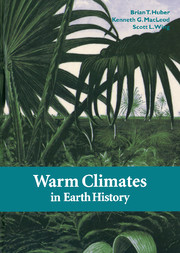Book contents
- Frontmatter
- Contents
- List of contributors
- Preface
- Part 1 Approaches to the study of paleoclimates
- 1 Warm climate forcing mechanisms
- 2 Recent advances in paleoclimate modeling: toward better simulations of warm paleoclimates
- 3 Comparison of zonal temperature profiles for past warm time periods
- Part II Case studies: latest Paleocene–early Eocene
- Part III Case studies: Mesozoic
- Part IV Case studies: Paleozoic
- Part V Overview: climate across tectonic timescales
- Index
- Plate section
2 - Recent advances in paleoclimate modeling: toward better simulations of warm paleoclimates
from Part 1 - Approaches to the study of paleoclimates
Published online by Cambridge University Press: 06 July 2010
- Frontmatter
- Contents
- List of contributors
- Preface
- Part 1 Approaches to the study of paleoclimates
- 1 Warm climate forcing mechanisms
- 2 Recent advances in paleoclimate modeling: toward better simulations of warm paleoclimates
- 3 Comparison of zonal temperature profiles for past warm time periods
- Part II Case studies: latest Paleocene–early Eocene
- Part III Case studies: Mesozoic
- Part IV Case studies: Paleozoic
- Part V Overview: climate across tectonic timescales
- Index
- Plate section
Summary
ABSTRACT
Numerical climate models have been applied to problems of paleoclimatology for several decades. During that time, climate models have progressed in complexity from relatively simplistic Energy Balance Models (EBMs) to sophisticated three-dimensional General Circulation Models (GCMs) of the atmosphere and oceans. Recent advances in climate modeling, mainly the incorporation of climate system processes once generalized or ignored and the interactive ‘coupling’ of climate system components, are leading toward more realistic paleoclimate simulations and a new understanding of warm paleoclimate dynamics. The future promises even more comprehensive models running at higher resolutions, allowing paleoclimate modeling studies to focus on subcontinental to regional-scale problems. However, as the models gain sophistication, paleoclimate modeling strategies become more complex. The set-up and initialization of GCMs using Atmospheric General Circulation Models (AGCMs) coupled to full-depth, dynamical Ocean General Circulation Models (OGCMs) will provide one of the primary challenges for the paleoclimate modeling community in coming years.
INTRODUCTION
Climate, defined as the mean state of the atmosphere along with some statistical description of variability, has undergone constant change throughout earth history. Paleoclimatology is the study of those ancient climates. Perhaps no subject within the earth sciences is as interdisciplinary, bringing together atmospheric science, oceanography, biogeochemistry, biogeography, and paleontology with the solid-earth sciences of geology, marine geology, and geophysics.
- Type
- Chapter
- Information
- Warm Climates in Earth History , pp. 21 - 49Publisher: Cambridge University PressPrint publication year: 1999
- 2
- Cited by

